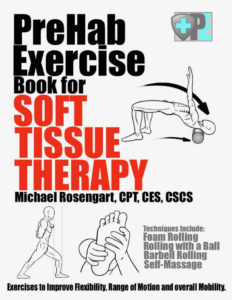Strength Sensei Bookshelf

PreHab Exercise Book for Soft Tissue Therapy
A complete guide for self-treatment soft-tissue methods
Self-administered soft tissue treatments are a relatively new trend in athletic fitness training and they are here to stay. The amount of information about how to use these methods is overwhelming, but there is a single resource that explains what these methods can do and how to do them.
The book is called PreHab Exercise Book for Soft Tissue Therapy (2016) by Michael Rosengart. The subtitle is “Exercises to Improve Flexibility, Range of Motion, and overall Mobility.” It’s 184 pages, but don’t get scared as it’s more of a reference book and contains large illustrations.
Rosengart doesn’t have a Ph.D. after his name and his educational credentials include several prestigious personal training certifications, such as those offered by the National Strength and Conditioning Association and the National Academy of Sports Medicine. What he does have is two decades of hands-on experience as a personal trainer and an instructor for personal trainers and those involved in health care. His material is written for a general audience, and the illustrations that he did himself are outstanding.
 Written for a general audience and well-illustrated, PreHab Exercise Book for Soft Tissue Therapy is a practical resource for self-administered soft tissue treatments.
Written for a general audience and well-illustrated, PreHab Exercise Book for Soft Tissue Therapy is a practical resource for self-administered soft tissue treatments.
Rosengart contends that the soft tissue methods presented in his book will improve mobility and “assist in cellular recovery and regeneration.” The first statement may be “a bit of a stretch.”
For example, a study on the effects of foam rollers on hamstring flexibility was published in 2006. It involved 23 college women and men who lacked flexibility in their hamstrings. The subjects performed foam rolling exercises for two months. At the end of the study, the researchers concluded that there were “no significant difference in the interaction between the treatment and control group’s pre- and post-measurements.” But there’s another side to this coin.
Consider that a study published in 2013 found that foam rolling on the quadriceps “was an effective treatment to acutely enhance knee joint ROM [range of motion] without a concomitant deficit in muscle performance.” So, at least for mobility (and unlike the Amber Heard vs. Johnny Depp Trail), the jury is still out on this one.
For mobility, Charles R. Poliquin was especially fond of the fascial stretching methods promoted by Chris and Ann Frederick, along with Active Release Techniques Treatment®, and he frequently promoted these methods in his seminars and articles. However, the Strength Sensei was a fan of foam rolling before a workout to relax and align the spine.
PreHab Exercise Book for Soft Tissue Therapy is organized into the following sections:
- Introduction
- Soft Tissue Therapy
- Practicing Soft Tissue Therapy
- Mobility
- Common Patterns of Compensation and Movement Dysfunctions
- Foam Rolling
- Rolling with a Ball
- Barbell Rolling
- Self Massage
- Appendix A: Soft Tissue Therapy Diagrams Per Joint
- Appendix B: Maps of Common Compensation Patterns
- Appendix C: Resources
The book can be read start-to-finish or as a reference source for those looking for a “quick fix” for a specific soft-tissue problem. For example, Rosengart has a section on what forward head posture is and why it’s a problem, then prescribes specific exercises to treat it.
PreHab Exercise Book for Soft Tissue may not be the ultimate source for self-administered soft tissue treatments, but it comes close. If you’re interested in using these methods or teaching them to others, save yourself some time and pick up a copy. (TSS)
[You can purchase PreHab Exercise Book for Soft Tissue Therapy by Michael Rosengart, CPT, CES, CSCS, through Amazon.com. It is available in paperback and Kindle versions.]
